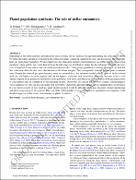| dc.contributor.author | Ndugu, Nelson | |
| dc.contributor.author | Oyirwoth, Patrick Abedigamba | |
| dc.contributor.author | Andama, Geoffrey | |
| dc.date.accessioned | 2022-03-09T14:13:25Z | |
| dc.date.available | 2022-03-09T14:13:25Z | |
| dc.date.issued | 2022-02-28 | |
| dc.identifier.citation | Ndugu, N., Abedigamba, O. P., & Andama, G. (2022). Planet population synthesis: The role of stellar encounters. Monthly Notices of the Royal Astronomical Society. | en_US |
| dc.identifier.issn | 1365-2966 | |
| dc.identifier.uri | http://dir.muni.ac.ug/xmlui/handle/20.500.12260/446 | |
| dc.description.abstract | Depending on the stellar densities, protoplanetary discs in stellar clusters undergo: background heating; disc truncation-driven by stellar encounter; and photo-evaporation. Disc truncation leads to reduced characteristic sizes and disc masses that eventually halts gas giant planet formation. We investigate how disc truncation impacts planet formation via pebble-based core accretion paradigm, where pebble sizes were derived from the full grain-size distribution within the disc lifetimes. We make the best-case assumption of one embryo and one stellar encounter per disc. Using planet population syntheses techniques, we find that disc truncation shifts the disc mass distributions to the lower margins. This consequently lowered the gas giant occurrence rates. Despite the reduced gas giant formation rates in clustered discs, the encounter models mostly show as in the isolated field; the cold Jupiters are more frequent than the hot Jupiters, consistent with observation. Moreover, the ratio of hot to cold Jupiters depend on the periastron distribution of the perturbers with linear distribution in periastron ratio showing enhanced hot to cold Jupiters ratio in comparison to the remaining models. Our results are valid in the best-case scenario corresponding to our assumptions of: only one disc encounter with a perturber, ambient background heating and less rampant photo-evaporation. It is not known exactly of how much gas giant planet formation would be affected should disc encounter, background heating and photo-evaporation act in a concert. Thus, our study will hopefully serve as motivation for quantitative investigations of the detailed impact of stellar cluster environments on planet formations. | en_US |
| dc.publisher | Royal Astronomical Society | en_US |
| dc.subject | Accretion | en_US |
| dc.subject | Hydrodynamics | en_US |
| dc.subject | Protoplanetary discs | en_US |
| dc.title | Planet population synthesis: The role of stellar encounters | en_US |
| dc.type | Article | en_US |

